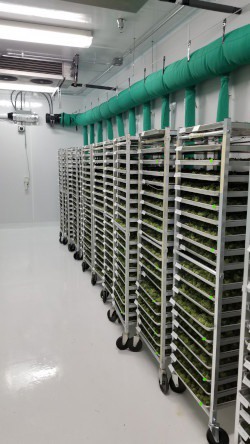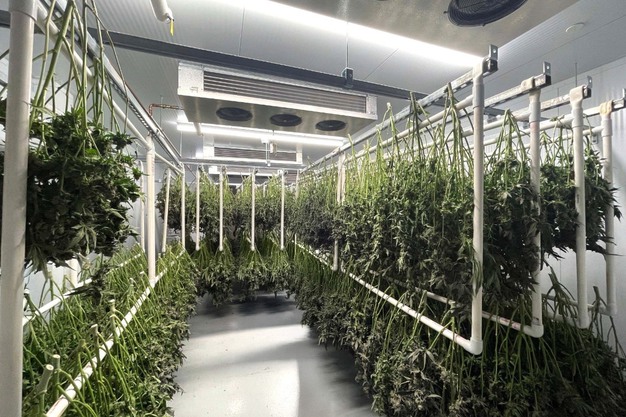Drying, curing, and storing cannabis has long been a game of guesswork. Most growers made do with whatever was on hand, repurposed HVAC units, a few dehumidifiers, and a whole lot of turkey bags. It wasn't ideal, but it worked well enough. Now, though, as the industry grows up and expectations rise, those old-school methods are starting to fall apart. "People have been using comfort cooling systems, equipment never designed for cannabis, to try and dry product," says David Sandelman, co-founder of Cannatrol. "The problem is, that gear just keeps removing moisture no matter what. If you don't stop the process at the right time, you end up overdrying the smaller flowers and turning them into dust."
As weird as it may sound, the solution from that can be found in cheese. Or rather, the processes that the dairy industry dry and store their products. After all, that too is a very moisture-sensitive industry. With a bit of intuition, the Cannatrol team has repurpose that technology specifically for cannabis. The key is not removing moisture, but rather to control water activity.
Jane Sandelman, a 15-year veteran of the cheese business (and still active in it), was already familiar with the delicate science of moisture management. "In cheese, just like in cannabis, the goal is to remove enough available water so it doesn't rot, but not so much that you lose weight or damage the product," she explains.
From proof-of-concept to passion project © Cannatrol
© Cannatrol
The Cannatrol system wasn't initially developed for cannabis, but it didn't take long to see the potential. After a few informal trials, a grower told them that flower dried using the Cannatrol system was 'some of the best they'd ever seen.' "That was all the proof they needed," she remarks
Since then, Cannatrol has scaled up, selling both retrofit solutions and prefabricated units (the DC series) that can be installed almost anywhere, think of it like IKEA for cannabis post-harvest rooms, only with global patents and GMP potential. "Our customers range from grandmas to MSOs," Jane says. "It's the same technology, just scaled to fit."
Vapor pressure: the science behind the cure
At the heart of Cannatrol's solution is vapor pressure control. "It's like the air pressure in a tire," David explains. "If you control vapor pressure in the room, all the flowers stay in equilibrium. You're not constantly pulling moisture out and hoping for the best."
That equilibrium is key, not just for quality, but for consistency. "With legacy systems, timing was everything," Jane adds. "When there are all different flower sizes left to dry,some would dry faster than others. If you didn't get those out of the room at just the right moment, you could destroy them. You'd end up calling your crew on a Saturday night to fix it, and no one's happy about that."
With Cannatrol, growers don't need to babysit their buds. "You harvest the flower, put it in the room, come back 10 days later, and enjoy," David says with a chuckle.
Better terpenes, less trichome damage
Controlled vapor pressure doesn't just improve ease of use, it protects the product itself. Recent data from Cannatrol's collaboration with the Cannabis Research Coalition (CRC) shows that legacy systems rupture around 25% of trichomes during drying and curing. Cannatrol's solution? Just 2%. "The trichomes are the factories," David says. "That's where the cannabinoids and terpenes are made. If you're destroying them, you're destroying your product."
The difference is noticeable. "Our customers, both commercial and consumer, say it's night and day," Jane adds. "I've worked in consumer-packaged goods for years, and this is the first time people send me love letters about a product."
From craft to global scale
Cannatrol's systems are now in use across the globe, from Thailand to Portugal, and are supporting growers in both medical and adult-use markets. The company offers GMP-compliant solutions for licensed producers, and home grow kits for patients looking for more control over their medicine.
And as post-harvest practices become a defining factor in product quality, the Cannatrol team is already expanding its research. "We're working on two test rooms right now to monitor VPD [vapor pressure deficit] not just in the dry/cure space, but also in the grow room," David says. "Once we have enough side-by-side data, we'll start scaling up that offering too."
 © Cannatrol
© Cannatrol
Storage, consistency, and post-harvest
Cannatrol's value doesn't stop at curing. Proper storage is increasingly critical, not just to maintain quality, but also to stabilize product for long-term use or market arbitrage.
"If you're rolling pre-rolls, for example, you need to homogenize flower to the right moisture level so the machines run efficiently," Jane explains. "We help producers get there."
Ultimately, the key is control. "Post-harvest has always been the wild west of cannabis," David says. "Everyone's been focused on growing better plants with better lights, better nutrients, better genetics, but once you harvest, you're only halfway there. The rest is about what you do after."
And as Jane puts it, the more control you have post-harvest, the more room you have for creativity. "It's like wine," she says. "Every cultivar, every grower, has their own magic. We just give them the tools to make that magic happen consistently."
For more information:
Cannatrol
www.cannatrols.com










